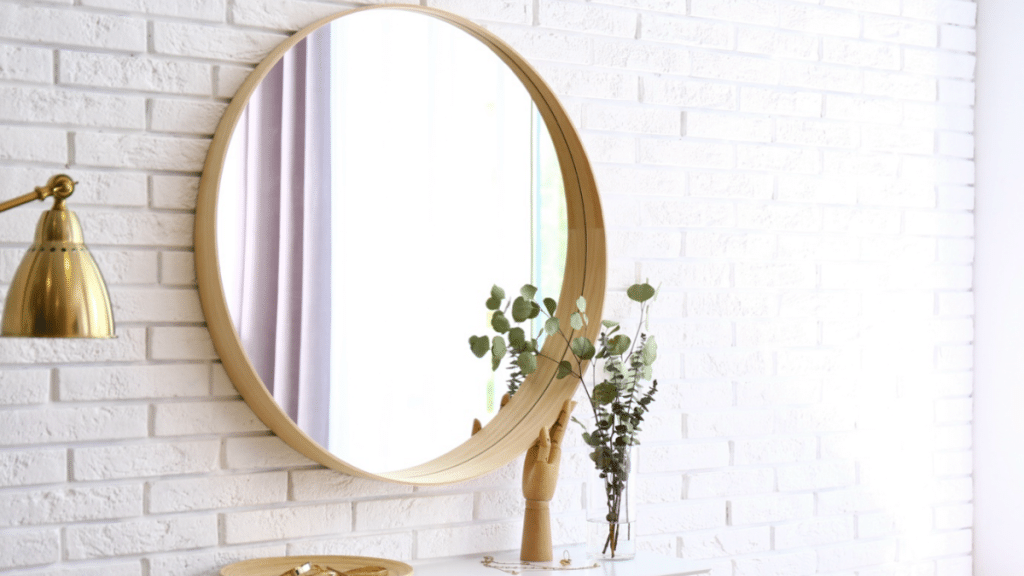Mirrors are not just practical household objects; they are also potent symbols in culture and art and vital tools in architecture and interior design. This article explores the history, evolution, and various uses of mirrors, as well as current trends in mirror design and how they can transform spaces.
A Brief History of Mirrors
Origins in Antiquity
The earliest mirrors were not made of glass, but of polished stone, metals like bronze, and later, silver. These were found in several ancient civilisations, including Egypt, Mesopotamia, and China, where they were used primarily by the elite for both practical and ceremonial purposes.
The Renaissance – Innovation in Glass
The small Italian island of Murano played a pivotal role in the development of the modern mirror. In the 15th century, Venetian craftsmen improved the technique of backing a glass pane with a reflective metal amalgam, significantly enhancing the mirror’s reflective quality. This innovation made Venice the centre of mirror production during the Renaissance.
Industrial Advancements
The industrial revolution brought about significant changes in mirror manufacturing. The introduction of the silvered-glass mirror in 19th century Germany, using a silver nitrate solution, made mirrors more reflective and less costly to produce, thus more accessible to the general public.
The Role of Mirrors in Interior Design
Expanding Spaces
One of the most common uses of mirrors in interior design is to make a small space feel larger. Placed strategically, mirrors create the illusion of depth and expand visual perception of space. They are often used in small rooms, narrow hallways, and areas with limited natural light.
Enhancing Light
Mirrors effectively enhance light within a space by reflecting natural and artificial light. This not only brightens a room but can also contribute to energy savings by reducing the need for artificial lighting during the daytime.
Decorative Art
Beyond their practical applications, mirrors serve as dynamic pieces of art. Designers and homeowners use framed mirrors, often with elaborate and ornate detailing, as focal points in room decor. Modern innovations have also seen mirrors with etched, stained, or bevelled edges, adding artistic elements to functional pieces.
Mirror Types and Their Uses
Wall Mirrors
Wall mirrors are the most common type and vary widely in size and shape. They are used not only in bathrooms and bedrooms but also as decorative elements in living rooms and dining areas.
Floor Mirrors
Floor mirrors add drama and style to a space. They are typically full-length and are either freestanding or designed to lean against a wall, ideal for dressing rooms and bedrooms.
Mirrored Furniture
Mirrored furniture, such as tables, wardrobes, and cabinets, incorporates mirrors into its structure. This furniture reflects light beautifully and adds a touch of luxury and sophistication to any interior.
Technological Innovations in Mirrors
Smart Mirrors
In the digital age, mirrors have embraced technology. Smart mirrors display information and interact with users. They can show news, weather, emails, or social media updates, and are increasingly popular in bathrooms and bedrooms.
LED Mirrors
LED mirrors, often found in bathrooms and dressing rooms, combine lighting and mirror technology to provide illuminated, shadow-free reflection. They are especially useful in places where precision grooming or makeup application takes place.
One-Way Mirrors
One-way mirrors, or two-way mirrors, are coated with a partial reflective layer that allows light to pass through one side while reflecting from the other. These are used for privacy and surveillance in certain commercial settings.
Current Trends in Mirror Design
Minimalist Designs
Current trends lean towards clean, minimalist designs with sleek, simple frames or even frameless designs. These complement modern decor and emphasise functionality without sacrificing style.
Vintage and Rustic
At the other end of the spectrum, vintage and rustic mirror designs are seeing a resurgence, particularly in settings that aim for a warm, homely atmosphere. These mirrors often feature ornate wooden frames and distressed finishes.
Integrated Mirror Installations
Integrated mirror installations, where mirrors are built into walls or furniture in unexpected ways, are becoming popular for their innovative and custom appeal. They offer unique design solutions that can transform ordinary spaces into visually stunning environments.
Mirrors – From Luxury To Essentials
Mirrors have evolved from luxury items in ancient times to essential elements in modern homes and public spaces. Whether used for practical purposes, such as grooming and room enhancement, or as decorative focal points, mirrors have the unique ability to transform spaces through reflection and light. As technology and design trends continue to develop, mirrors will likely play an even greater role in architectural and interior design, reflecting both our physical and aesthetic needs.
